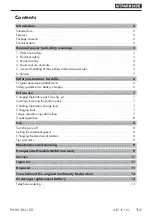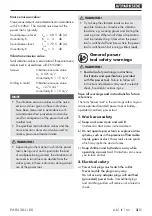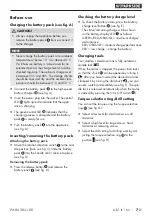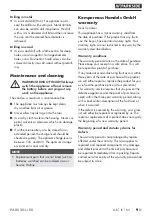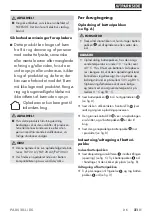
PABS 20-Li D5
■
8
│
GB
│
IE
│
NI
2-speed gearbox
CAUTION!
►
Operate the speed selector switch only
when the appliance is at a standstill. Other-
wise the appliance could be damaged.
In first gear (speed selector switch
in posi-
tion 1)
(see fig. I)
you can reach a speed of approx. 400 rpm and a
high torque. This setting is suitable for all screwing
jobs.
In second gear (speed selector switch
in
position 2)
(see fig. J)
you can reach a speed of approx. 1400 rpm for
carrying out drilling work
Use
Switching on/off
Switching on
♦
Press and hold the ON/OFF switch to start
up the appliance (see fig. K).
The LED working light lights up when the
ON/OFF switch is pressed lightly or fully.
This provides illumination of the work area in
poor lighting conditions.
Switching off
♦
Release the ON/OFF switch to switch off
the appliance.
Setting the rotational speed
The ON/OFF switch has a variable speed
control. Press the ON/OFF switch lightly for a
low speed. Increasing the pressure increases the
speed (see fig. K).
NOTE
►
The integrated motor brake ensures that the
appliance stops quickly.
Changing the direction of rotation
♦
Change the direction of rotation by pressing
the rotation direction switch towards the left
or right (see fig. L).
Tips and tricks
Tip! How to do things correctly.
♦
Before operation, check whether the screw or
drill insert is correctly fitted, i.e. centred in the
drill chuck.
♦
Screw bits are labelled according to their di-
mensions and their shape. If you are uncertain,
always check first whether the bit fits tightly in
the screw head without any play.
Torque
♦
Smaller screws/bits can be damaged if you
set too high a torque or too high a speed.
Hard screw joints (in metal)
♦
Particularly high torques occur, e.g. in metal
screw joints made using drive sockets.
Select a low rotational speed.
Soft screw joints (e.g. in soft wood)
♦
Here, too, use a low speed to avoid damaging
the wood surface when it comes into contact
with the metal screw head. Use a countersink.
When drilling in wood, metal and other
materials, observe the following
♦
Use a high speed for drill bits with a small
diameter and a low speed for drill bits with
a large diameter.
♦
Select a low speed for hard materials and
a high speed for soft materials.
♦
Secure or fasten the workpiece in a clamp
or vice (if possible).
♦
Mark the spot where you want to drill with a
punch or nail. Select a low rotational speed
when you start drilling.
♦
Pull the rotating drill bit out of the hole several
times to remove dust and chips and clear the
hole.
IB_331803_PABS20-LiD5_LB6.indb 8
25.02.20 15:01
Содержание PABS 20-Li D5
Страница 3: ...A ...
Страница 5: ...B C D E F G ...
Страница 6: ...H I J K L ...
Страница 20: ...PABS 20 Li D5 14 GB IE NI ...







